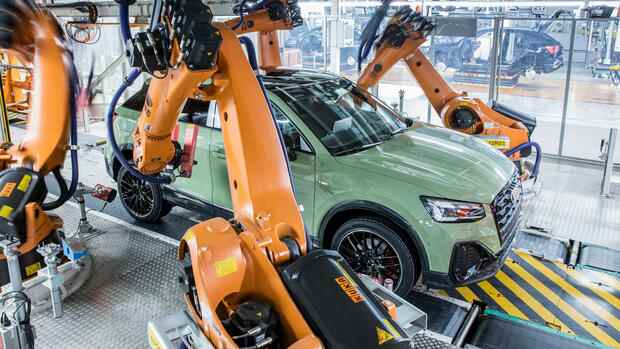At Audi, slightly fewer vehicles roll off the assembly line – but the prices per unit are significantly higher.
(Photo: Audi)
Dusseldorf Germany’s premium manufacturers are defying the falling car sales figures. After Mercedes, Audi can also present strong half-year figures on Friday. The Ingolstadt Volkswagen subsidiary has increased its operating result by around 59 percent, although sales have fallen by 20 percent over the same period. With 4.9 billion euros, it has reached a record, said CFO Jürgen Rittersberger on Friday in Ingolstadt.
Audi can even set itself apart from Mercedes. The operating return on sales was 16.5 percent. The Stuttgart carmaker, which presented its figures for the first half of the year on Wednesday, came up with just over 15 percent. This is interesting because, unlike Audi, Mercedes is pursuing a clear margin-oriented strategy and will in future dispense with volume models in the mid-price segment.
Mercedes is planning long-term sales of around two million units, while Audi boss Markus Duesmann recently reaffirmed the goal of three million vehicles produced annually.
The fact that Audi nevertheless achieved a higher margin than Mercedes in the first half of the year is also due to the carmaker’s first-time consolidation of the luxury brand Bentley in the Audi balance sheet. The British contributed almost 400 million euros to the operating result. Similar to Mercedes, Audi can push through higher car prices due to the general lack of supply in the car market. This also makes it possible to compensate for higher raw material and energy prices.
Top jobs of the day
Find the best jobs now and
be notified by email.
Overall, Audi delivered around 785,000 vehicles of its own brand worldwide in the first half of the year, after just under 982,000 in the previous year. Of these, around 50,000 were fully electric vehicles. Compared to the same period of the previous year, sales of purely electrically powered cars at Audi have increased by more than 50 percent.
In Europe, the decline in sales was limited at 13 percent. In China, Audi’s most important market, sales fell by almost 24 percent. However, Audi has a much bigger problem in the USA. Apparently, the models are not well received there. Sales here fell by almost 32 percent.
Raw material hedging transactions still contributed 400 million to the result – far less than in the first quarter because raw material prices had normalized significantly, said Rittersberger. The bottom line was a profit of 4.4 billion euros after taxes.
Looking at the year as a whole, Audi remains cautious. In contrast to Mercedes, which has raised its annual targets, the Ingolstadt-based company is sticking to its target of a return on sales of nine to eleven percent. Net cash flow is expected to be in a corridor between EUR 4.5 and 5.5 billion.
Audi expects catch-up effects in China
As reasons for the decline, Rittersberger cited declining special effects from securing raw materials and residual values of used vehicles, increasing research and development costs and increasing sales figures in China. Audi posts the income from the Chinese plants in the financial result and not in the operating result. For the year as a whole, the Executive Board expects a slight increase in sales to 1.8 to 1.9 million vehicles and a strong increase in sales to 62 to 65 billion euros.
In China, there should be catch-up effects after the corona lockdowns, said Rittersberger. But due to recurring bottlenecks in the supply of semiconductors, Audi has applied for short-time work as a precaution for the Ingolstadt and Neckarsulm plants. And “the cost of materials is increasing, especially for the batteries,” said the chief financial officer.
In addition, Audi expects higher upfront investments in future technologies. The research and development cost ratio will therefore be above the corridor of six to seven percent.
Among other things, the expenses for the vehicle software are likely to be decisive for this. Among other things, Audi and the Volkswagen Group are pursuing two independent development strands in the development of automated driving functions in the medium term, which will result in additional expenditure for the entire Group of around 500 million euros.
More: Audi wants to halve factory costs

